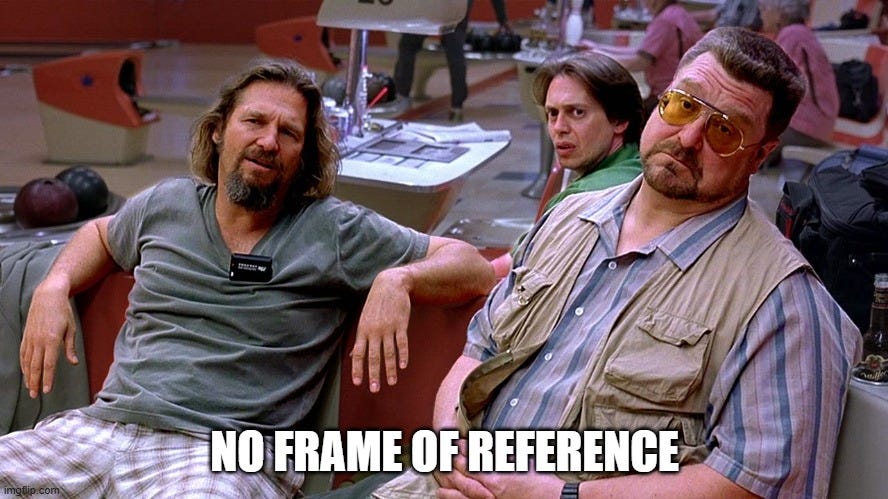A lexicon of futures
We lack a frame of reference in conceptualizing future time periods. Let's create one.
In the Big Lebowski, Walter accuses Donnie of lacking “a frame of reference” and acting “like a child who wanders into the middle of a movie.” That’s exactly how I feel in discussing the future. We lack a frame of reference to guide our thoughts and discussions. The English language (and, for what I know, the Spanish, Italian, and Latin languages) lack useful terminology for distinguishing one future time frame from another.
We say things like “down through the generations”, “across the sands of time”, “more lasting than bronze”, and “happily ever after”. We also say things like “in the future” or “in the far future”. But what do those mean? They do mean “a long time” from now, but only in dimensionless, vague, and highly contextualized senses. We need to do better than that if we intend to realistically conceptualize the future.
What we need is a lexicon of future time periods. And since I’m not aware of one that exists for this purpose, let’s make one up.
Unintuitively unintuitive
In creating a frame of reference about future time, the obvious choice is exact quantification. Time is measurable, after all, so let’s measure it. We have convenient timeframes already made for us: a year, a century (100 years), a millennium (1,000 years), and even the rarely-cited-outside-of-science Myr (megayear, or 1,000,000 years) and Gyr (gigayear, or 1,000,000,000 years). (Btw, not sure if scientists actually say “meers” and “gears” for these last two.)
Easy! Right?
Meh. Doesn’t feel that way.
Unintuitively, exact quantification using these temporal yardsticks feels unintuitive. Futurism is not alone on this one. It’s the same in many other fields. For example:
In history, we often name time periods even though we can quantify them by reference to years, decades, centuries, or millennia. The European Middle Ages for instance refers to the millennium between the fall of the Roman Empire in western Europe and the European Renaissance.
In geology, the “Geologic Time Scale” in wide use among practitioners classifies deep geologic time not by reference to number of years in the past but by a system of eons, eras, periods, epochs, and ages. All of these can be defined by reference to years, millenia, or Myrs in the past. But instead geologists have named them things like “Devonian” and “Jurassic” and “Holocene”. It would be a good guess to imagine these names have some systematic, relational meaning (like maybe they’re in alphabetical order). But you would be wrong. They’re named for a variety of places, rock layers, tribes, and other things. It’s very arbitrary, and yet geologists favor their use over more numerical terminology in technical discussions.
In geography, those of us in “the West”, with our Eurocentric mindsets, categorize the entirety of Asia — the world’s largest continent — into the "Near East” (the region between the Mediterranean and the Persian Gulf), the “Middle East” (from the Persian Gulf eastward to include Iran and Afghanistan and maybe a little farther), and the “Far East” (everything else to the Pacific Ocean). Never mind that Asia is 5,000 miles wide east to west, and the Near and Middle Easts together only represent the easternmost ~40% of that. And never mind that at least 75% of the Easts’ population resides in the Far East. We still find these distinctions more useful in many contexts than, say, the Easternmost 800 miles, the next Easternmost 1400 miles, and the remaining 2,800 miles of the Asian continent.
Et tu, physics? Even also. Even though we can always be numerically precise about wavelengths of radiation, scientists frequently refer to various parts of the electromagnetic spectrum by names like visible, infrared, ultraviolet, x-ray, microwave, etc.
Why do we humans do this? Why do we unintuitively use imprecise, arbitrary names for what can be precisely quantified?
Certainly there’s a convenience factor of having names for ranges within quantifiable scales. It’s somehow more convenient to say “in the late Devonian” than “somewhere between 380 and 358.9 Myrs ago”.
There is also a usefulness to the vagueness that names, and not numbers, impart. Taking one of our examples above, when did the Roman Empire actually fall in the West and kick off the Middle Ages? Was it when Alaric and the Visigoths sacked the Ancient City in 410 CE? Or when Odoacer deposed Romulus Augustus in 476? For that matter, when did the Middle Ages end? When Icelandic Vikings colonized Greenland around the year 1000, becoming the first Europeans since the Romans to once again colonize beyond their borders? Or when Dante published the Divine Comedy in c. 1321, inspiring new, authentic literatures to be created in the vernacular romance languages? Here there is a definite vagueness that the precision of numbers would fail to capture precisely.
Names rather than numbers can also mask ignorance, which may be the case with our use of terms like the Middle East and Far East.
Finally, and maybe most importantly, naming quantifiable ranges has the benefit of imparting context to the users of those terms. The term “Middle Ages” reflects the widely held (though inaccurate) belief that this time period exists between two more interesting, higher ages in Western history: the Roman Empire and the Renaissance.
Naming the future
Naming the future presents difficulties. Straight numerics don’t feel right. But since the future literally doesn’t exist yet, there’s very little context to fall back on in coming up with intuitive names for time frames.
But there is some. So presented below is my take — my, like, opinion, man — on appropriate frames of reference for conceptualizing realistic futurism.
Immediate future = the next 10 years. This timeframe effectively represents the present day and covers almost every future length of time that people envision for practical planning purposes — personally and professionally. Taking out a mortgage and saving for retirement might be the only typical exceptions that go beyond the immediate future. This is also the time frame in which we imagine very little will change technologically relative to the present.
Near future = beyond the immediate future until 100 years from now. This timeframe corresponds approximately to the length of a (long) human life. In that regard, we can intuit the scale of it directly. But the near future — particularly the farther we wander from the immediate future — is where our imaginations start to veer off course in the direction of science fiction and fantasy. We probably don’t see much being different in 30 years when we pay off our mortgage. In 85 years? Anything could happen.
Middle future = beyond the near future until 1,000 years from now. It feels right to represent a millennium in my lexicon of the future. 1,000 Years is a meaningful increment of all of recorded human history. A lot has happened and can happen in 1,000 years. It’s a nearly unimaginable long time to most humans, but it is graspable, and it’s not that long in the scheme of things. Hence “middle”.
Far future = beyond the middle future until 100,000 years from now. I debated where to cut this off, but settled on 100,000 years. Just as a millennium is a meaningful increment of recorded human history, so 100,000 years is a meaningful increment of our species’ age (~300,000 old). While it’s hard to imagine what life may be like anywhere in the far future (the hardest thing to imagine being that life then will be just like life now!), based on our own species’ history, it’s eminently reasonable to think humans will still be around at the end of the far future period.
Extreme far future = 100,000 years from until 500 million years from now. This is a huge time period — the “Far East” in my frames of reference, if you will. But it’s not entirely arbitrary. As I mentioned in a prior post, the Earth will probably become uninhabitable for most life in about half a billion years. So unless humans move out of Earth (and I don’t think they ever will, but we’ll save that for a post in the immediate future), the extreme far future — earlier or later — will see the end of humanity.
Ultra far future = everything that follows the extreme far future. “Ultra” in Latin means “beyond”, and beyond the far future is probably beyond humanity. The ultra far future might extend billions or trillions or googols of years from now.1 It might just extend forever. In any case, it will go beyond anything humanity will ever touch directly.
Westward the wagons, across the sands of time
I’m glad we got this post out of the way. It’s a bit tedious, I know. But in my recent writings about realistic futurism, I’ve felt frame-of-reference-less, like a rambler or a tumbling tumbleweed, wandering across the sands of future time with no bumpers in the lane gutters, so to speak.
Now we have some.
For reference, here’s the recap
Pay attention, because we’ll be using them in the immediate future.
Immediate future = the next 10 years.
Near future = 10 to 100 years from now.
Middle future = 100 to 1,000 years from now.
Far future = 1,000 to 100,000 years from now.
Extreme far future = 100,000 to 500 million years from now.
Ultra far future = everything that follows the extreme far future.
This is a great video — “The Last Thing to Ever Happen In The Universe” — by Kurzgesagt – In a Nutshell that will boggle the mind on timescales in the ultra far future.






